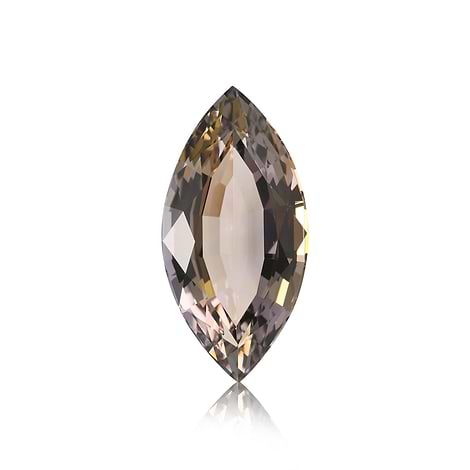
A Leibish Tanzanite Cushion & Marquise Diamond Ring (3.37Ct TW)
As much as diamonds truly are a spectacular specimen, they are a perfect example of how supply and demand works, as well as marketing in general. Diamonds are certainly hard to come by, and are marketed as such. However, there are plenty of other commodities, and gemstones in particular that are just as rare as diamonds if not rarer. Tanzanite happens to be a semi-precious gemstone that is far rarer than diamonds and yet is valued far less than the hardest substance known to man. While other factors play a part when determining the overall worth of a stone such as appearance and durability, one would think that the element of rarity would have more of an effect on the price of the stone. This reality has an upside as well as a downside, depending on how you look at it. Diamonds may be easier to come across, but they come at a steep price. Tanzanite on the other hand, although not quite diamonds, are far cheaper yet more difficult to hunt down. Here is a short comparison between these two intriguing gemstones.
Diamonds in a Nutshell
Found in many parts of the world, diamonds consist of a perfect internal structure that results in an extremely durable stone that is also capable of giving off an incredible and unparalleled shine. Their unusual sparkle and hardness is what has dubbed them as a girl’s best friend and is the stone of choice for brides-to-be all across the globe. There are four main factors to consider when looking for a diamond: color, cut, clarity, and carat weight. These are known as the 4 Cs. In colorless diamonds, all four elements are of equal importance whereas color takes precedence when it comes to color diamonds.
Tanzanite in a Nutshell
Unlike most gemstones, tanzanite was only discovered some forty or so years ago in Tanzania. The name tanzanite was given to the mineral zoisite, which is found in a number of hues, in order to market it. It was Tiffany’s that had this brilliant idea and now it is the name used to refer to the blue, bluish purple, and bluish violet varieties. Much like rubies, which are actually red sapphires, the name tanzanite is reserved for these colors alone although some will refer to some of the other colors as colorless tanzanite, gray tanzanite, yellow tanzanite, and so on and so forth. The rough stone often has more of a brownish red color, and only after heat treatment do many tanzanite stones transform into the blue gemstones many of us would recognize. Stones’ colors are often affected by elements found within the mineral. In the case of tanzanite, it is small traces of vanadium in the zoisite’s structure that causes the blue coloring. When such stone are heated to 600 degrees Celsius for thirty minutes, the blue coloring can come forth more. For this reason, almost all blue tanzanite on the market has been heat-treated. Those that are found with such a color naturally demand extremely high prices. In terms of durability, tanzanite ranks 6.5 on the Mohs scale of hardness, as opposed to diamonds, which rank 10.
Tanzanite Pear Side Stone Ring (2.74Ct TW)
Why Diamonds?
Diamonds should be sought after first and foremost for their durability. The second reason, which is equally important, is its one-of-a-kind shine. While this is less relevant in color diamond it is still important because of the structure of the stone. It will not exude the radiance that colorless diamonds, particularly brilliant-cut stones, are known for, but it will still display an overall dazzle that is incomparable to any other stone.
Why Tanzanite?
One of the arguments made in favor of diamonds is that they are special specimen for having been on our planet for so long and having had to endure such conditions to become what they are. In all fairness, many minerals have been formed in similar fashions overtime, albeit with different chemical makeups. Tanzanite is a rather recent player in the gemstone industry and yet it has so much to offer. Known mainly for the blue variety, which is a strong contender with blue sapphires and maybe even blue diamonds, its colorless variety has a place in the competition with colorless diamonds and other colorless gemstones as well. The most attractive feature of a tanzanite stone is its color. Needless to say, the presentation of a piece of tanzanite jewelry is phenomenal. Pair that with the low price of approximately $425 for a 1-carat stone and you’ve got yourself a great deal.
2.58 carat, Violet, Tanzanite, Heart Shape
The Bottom Line:
When it comes down to comparing a diamond with a tanzanite stone, it is hard to come away with a winner. The reason for this is that despite the common ground between the two stones, they are truly worlds apart. Diamonds are on top of the gemstone hierarchy whereas tanzanite is somewhere down below. It’s not just that it is so much less durable than a diamond and that it does not offer the brilliance, sparkle, or clarity of a diamond; it’s everything combined. Having said that, if you are looking for a stone with an awesome color that won’t break the bank, tanzanite definitely has one on diamonds, which will have a much harder time filling these specific needs.















